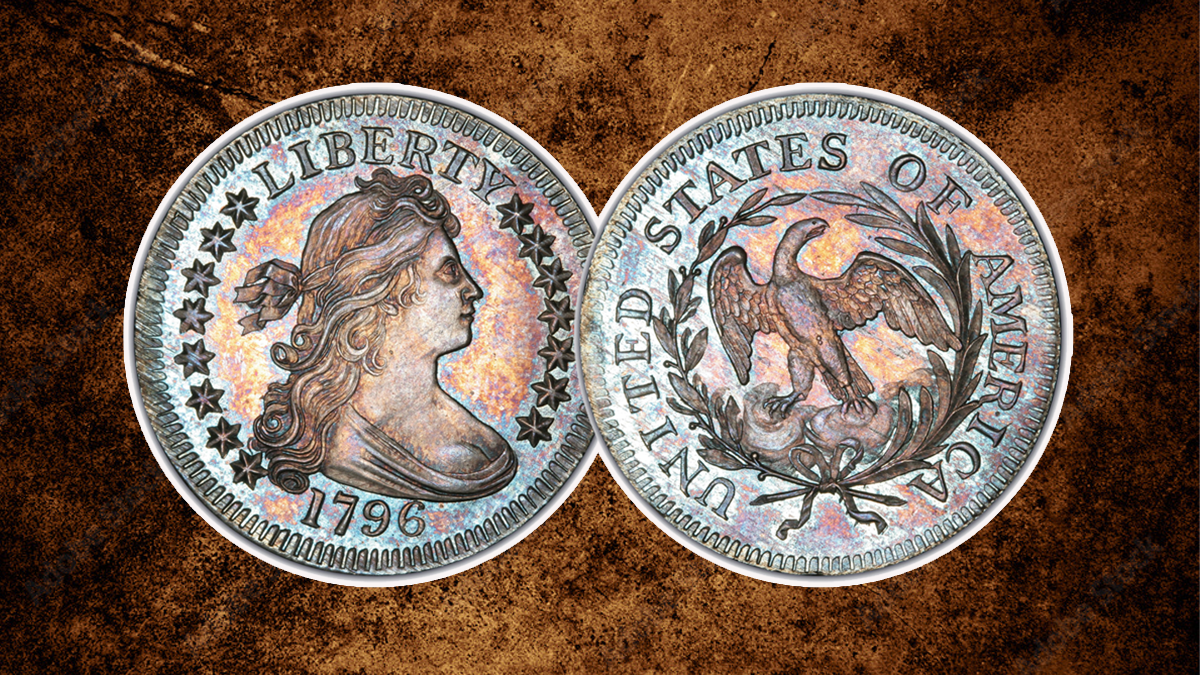
Congress authorized the 1796 Draped Bust Quarter with the Mint Act of 1792. Since it is a one-year type coin, type set collectors highly prize it.
This coin is essential to complete your collection, no issue whether you have a specialty quarter coin collection or a complete type set of US coins. Although the ratio of buyers to coins indicates this specific coin is not very rare, higher prices usually describe the result.
The obverse of these silver coins has an image of Mrs. William Bingham by Gilbert Stuart like each of the other draped bust coins. There were fifteen six-pointed stars surrounding the painting and also written overhead is LIBERTY, and below the portrait comes the year.
On the opposite side, a wreath made of olive with palm stems covers the small eagle flying in the heavens. Surrounding the bouquet, it also has the words UNITED STATES OF AMERICA.
History of the 1796 Draped Bust Quarter
The quarter-dollar denomination emerged as a compromise between tradition and Jefferson’s decimal plan for American coinage. It mirrored the Spanish colonial two reales, known colloquially as the “two bits,” which was deeply ingrained in 18th-century American commerce. Although initially proposed by Jefferson as a twenty-cent piece, the quarter dollar became official with the Mint Act of 1792, specifying its weight and silver content.
The first quarter dollars were minted in 1796, four years after the Mint’s establishment. Despite lacking an inscription of value, the 1792 “Eagle on Rock” coins are considered trial strikes for the denomination. The 1796 quarters caused a sensation, with a significant portion of the mintage surviving in high grades.
Basic Design of 1796 Draped Bust Quarter
In 1796, Congress responded to dissatisfaction with the Flowing Hair dollar by decreeing a new design for all denominations. This included the requirement for certain features: the eagle, the word Liberty, stars, and the United States of America. The coin’s value was not deemed necessary as it could be inferred from its size based on its precious metal content. Therefore, the denomination varied in size, with the half dime being the smallest silver coin and each subsequent denomination increasing in size up to the silver dollar.
Obverse: All coins (copper and silver) displayed the same front side. Robert Scot, Chief Engraver of the U.S. Mint from 1793 to 1823, transformed a portrait by Gilbert Stuart, believed to be of Philadelphia socialite Ann Willing Bingham, into a portrayal of Liberty. She remained largely unchanged for several years, except for adding an extra curl to her hair in 1798.
Reverse: There were three basic reverse designs. The first, used for copper coins, featured the coin’s value (half a cent or one cent) surrounded by a wreath or vine, with the words “UNITED STATES OF AMERICA” encircling the wreath. From 1795 to 1797, all silver coins depicted a scrawny, naturalistic bald eagle on the reverse, known as the Draped Bust, Small Eagle design.
Due to its low mintage, this design often commands a high price. In 1798, the Heraldic eagle replaced the small eagle, leading to the Draped Bust, Heraldic Eagle design. This design was also used on the famous 1804 silver dollar and the reverse of the Kennedy half dollar in 1964. Additionally, three denominations featured the appropriate fraction: half a cent (1/200), large cent (1/100), and half a dollar.
Specifications of 1796 Draped Bust Quarter
Designer: Robert Scot
Weight: 6.74 grams
Comp: 89.2% Silver, 10.8% Copper
Diameter: 27.5mm
Edge: Reeded
Circulation Mintage: 6,146
Obverse Text: 1796 | LIBERTY
Reverse Text: UNITED STATES OF AMERICA
Values
The 1796 Draped Bust Quarter is a coveted piece for collectors, being struck only in that year. Surviving examples are scarce, with a mintage of just 6,146 pieces. Even circulated examples command strong demand, while Mint State specimens are exceptionally rare and highly sought after by advanced numismatists.
1796 Draped Bust Quarter
PCGS MS-66
Sold for $1,527,500
1796 Draped Bust Quarter
PCGS MS-65
Sold for $230,000
1796 Draped Bust Quarter
PCGS MS-63
Sold for $172,500
1796 Draped Bust Quarter Rarity
For a long time, the 1796 quarter has been highly coveted by collectors assembling type sets of American coinage. Minted only in this single year, the Draped Bust obverse paired with the Small Eagle reverse is exceptionally rare considering the demand, as no type set can be considered complete without one.
The design is derived from the 1795 silver dollar, sharing the same motifs, initially appearing in the form of variety BB-51. The portrait is attributed to Gilbert Stuart. Notably, the 1795 Draped Bust half dime was planned but wasn’t utilized until 1796, being overdated. The sole coins with this motif are the 1795 silver dollars, existing in two die varieties (BB-51 and BB-52).
A mere 6,146 quarters were minted in 1796, using two pairs of dies. Many have been lost or melted over time, with a significant portion of high-grade coins originating from a hoard assembled by Col. Green. This small mintage has rendered it one of the scarcest early-type coins, highly sought after by advanced collectors.
Several examples exist in varying degrees of Mint State, with some being quite visually appealing. However, nearly all suffer from a flatly struck head, a persistent issue that troubled even experienced numismatists. Despite efforts to find sharply struck pieces, some collectors eventually settled for coins with a flatly struck head, given the rarity of the issue.
Unlike other silver denominations of 1796, a few quarter dollars seem to have been meticulously made, displaying prooflike surfaces, although not with sufficient care to fully bring out the details of the eagle’s head.
Grading Condition
Grading standards have evolved, but as of March 2024, CAC, NGC, and PCGS report a combined total of 78 surviving Mint State coins. The top population coins include a PCGS MS67, NGC MS67+, and CAC MS67, showcasing the rarity and desirability of high-grade specimens.
Also Read – 1933 Double Eagle: A Collector’s Guide
Conclusion:
The 1796 Draped Bust Quarter stands as a unique coin of American numismatic history. Authorized by Congress in 1792, this one-year type coin holds significant value for collectors, whether they specialize in quarter coins or seek to achieve a comprehensive type set of US coins. Despite its fairly low mintage of 6,146 pieces, staying examples are highly sought after, with even circulated specimens commanding strong demand. Mint State specimens are very rare and prized by advanced numismatists.
